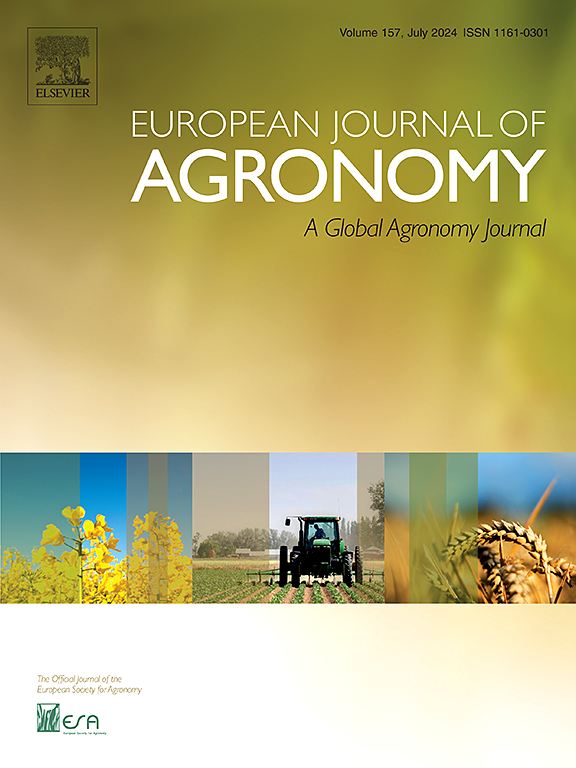Deciphering genotype × environment interaction for grain yield in durum wheat: an integration of analytical and empirical approaches for increased yield stability and adaptability
IF 4.5
1区 农林科学
Q1 AGRONOMY
引用次数: 0
Abstract
The development of stable and high-yielding wheat cultivars offers a sustainable solution to the challenge of food security and self-sufficiency in developing countries. The main goals of this study were to evaluate the effects of genotype, environment and genotype by environment (G×E) interaction on grain yield in durum wheat genotypes, to identify high-yielding and stable genotypes, and to identify climatic variables that significantly affect the G×E interaction. Twenty-one durum wheat breeding lines originating from ICARDA and CIMMYT, along with four national durum wheat cultivars, were evaluated using a randomized complete block design with three replications across seven locations (differing in winter temperature and rainfall) and three cropping seasons (2020–23). Four statistical models, including (i) additive main effects and multiplicative interaction (AMMI) (ii) genotype plus G×E (GGE) biplots, (iii) factorial regression (FR) and (iv) partial least squares (PLS) regression for investigating the G×E interaction for grain yield and identifying the climatic variables that significantly affect the G×E interaction, were applied. The combined analysis of variance indicated that the effects due to genotype, environment and the G×E interaction were highly significant (P < 0.01). The environment was the main source of variation and accounted for 94.2 % of the total grain yield variation, while the G×E interaction contributed 4.7 %, and the genotype contributed 0.5 %. The combined and yearly data analysis by the “which-won-where” pattern of the GGE biplot showed consistent results across years for environmental grouping, resulting in four mega-environments in durum wheat yield trials. These results suggested that the use of these genotypes could be recommended for deployment in their respective mega-environments. Both AMMI and GGE biplots approved selecting breeding lines G19, G12, G22 and G23 as high-yield and stable genotypes across diverse environments for further breeding programs and genotype recommendation. Based on the FR model, climatic variables related to monthly rainfall and temperature explained 69.5 % of the G×E interaction variation. Using the PLS biplot, the environments were separated based on temperature and rainfall, and the genotypes with the most sensitivity (i.e., G4, G9, G24, G25) or insensitivity (i.e., G23, G21 and G14) to climatic variables were identified. These findings provide relevant information for future durum wheat breeding programs that consider improved productivity and yield stability in durum wheat under climate change conditions.
解读基因型x 对硬粒小麦产量的环境相互作用:提高产量稳定性和适应性的分析和经验方法的整合
发展稳定高产的小麦品种为解决发展中国家粮食安全和自给自足的挑战提供了可持续的解决方案。本研究的主要目的是评价基因型、环境和基因型与环境(G×E)互作对硬粒小麦籽粒产量的影响,鉴定高产和稳定的基因型,并确定影响G×E互作的气候变量。采用随机完全区组设计,对来自ICARDA和CIMMYT的21个硬粒小麦育种品系以及4个国家硬粒小麦品种进行了评估,该设计在7个地点(冬季温度和降雨量不同)和3个种植季节(2020-23年)进行了3个重复。采用了四种统计模型,包括:(i)加性主效应和乘法相互作用(AMMI); (ii)基因型加G×E (GGE)双图;(iii)因子回归(FR)和(iv)偏最小二乘回归(PLS),用于研究G×E对粮食产量的相互作用,并确定对G×E相互作用有显著影响的气候变量。综合方差分析表明,基因型、环境和G×E互作对水稻产量的影响极显著(P <; 0.01)。环境是主要变异源,占总产量变异的94.2 %,G×E互作贡献4.7 %,基因型贡献0.5 %。通过GGE双标图的“孰胜孰负”模式进行的综合和年度数据分析显示,不同年份的环境分组结果一致,从而在硬粒小麦产量试验中产生了四个大型环境。这些结果表明,可以推荐使用这些基因型在各自的大环境中进行部署。AMMI和GGE双标图均批准选择G19、G12、G22和G23作为在不同环境下高产和稳定的基因型,用于进一步的育种计划和基因型推荐。基于FR模型,与月降雨量和温度相关的气候变量解释了G×E相互作用变化的69.5% %。利用PLS双标图,根据温度和降雨量进行环境分离,鉴定出对气候变量最敏感(即G4、G9、G24、G25)或最不敏感(即G23、G21和G14)的基因型。这些发现为未来在气候变化条件下提高硬粒小麦的产量和产量稳定性提供了相关信息。
本文章由计算机程序翻译,如有差异,请以英文原文为准。
求助全文
约1分钟内获得全文
求助全文
来源期刊

European Journal of Agronomy
农林科学-农艺学
CiteScore
8.30
自引率
7.70%
发文量
187
审稿时长
4.5 months
期刊介绍:
The European Journal of Agronomy, the official journal of the European Society for Agronomy, publishes original research papers reporting experimental and theoretical contributions to field-based agronomy and crop science. The journal will consider research at the field level for agricultural, horticultural and tree crops, that uses comprehensive and explanatory approaches. The EJA covers the following topics:
crop physiology
crop production and management including irrigation, fertilization and soil management
agroclimatology and modelling
plant-soil relationships
crop quality and post-harvest physiology
farming and cropping systems
agroecosystems and the environment
crop-weed interactions and management
organic farming
horticultural crops
papers from the European Society for Agronomy bi-annual meetings
In determining the suitability of submitted articles for publication, particular scrutiny is placed on the degree of novelty and significance of the research and the extent to which it adds to existing knowledge in agronomy.
 求助内容:
求助内容: 应助结果提醒方式:
应助结果提醒方式:


